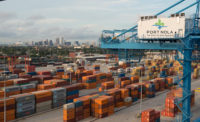In the evolving world of supply chain logistics, where paper documents are transitioning to electronic and end-to-end tracking of containerized cargo is becoming common on the Internet, a key focus area for North American ports is on speeding transport of containerized goods, including perishables.
According to a report by The Insight Partners, New York, the volume of high-value refrigerated container shipments is predicted to grow 6.7% per year between 2015-2020, driven by increased global demand for perishable commodities and advances in digital technologies designed to increase shipping efficiencies and reduce risks of delays, theft and spoilage.
Because of the high cost of shipping refrigerated containers and the cargo’s vulnerability to temperature fluctuations, cargo owners are keen to ensure the quickest, most reliable delivery from origin to destination.
That’s why the American Association of Port Authorities (AAPA), Alexandria, Va., shares information on emerging resources and solutions that help ensure ports’ business success.
For instance, in September 2015, The Port Authority of New York and New Jersey was said to be the first U.S. port to implement a sharable online shipper interface with its Terminal Information Portal System (TIPS). Developed by Sustainable Terminals Services Inc., Bayonne, N.J., this Internet tool compiles information on one platform from all six of the port’s terminals. It then provides data such as container availability, booking status, vessel schedules and information on where to return empty containers to qualified users in real time.
The result? Increased cargo handling efficiencies at the port authorities’ terminals.
In March, AAPA held its first-ever Smart Ports seminar, focusing on topics such as cloud computing, the Internet of Things (IoT), cybersecurity, data analytics, data portals and sharing, terminal operating systems and intelligent transportation systems. The host port, Port of Oakland, Oakland, Calif., showcased Oakland Portal, which provides a comprehensive digital view of vessel schedules and cargo and terminal information all in one place. The technology aligns with an industry migration toward digitalization of international supply chains to address challenges of tracking containerized cargo door-to-door.
To keep cargo flowing efficiently through America’s largest container port gateway, the ports of Los Angeles and Long Beach teamed with GE Transportation, Chicago, on an information portal called Port Optimizer, which uses digitized maritime shipping data and makes it available to cargo owners and supply chain operators through secure, channeled access. The purpose is to increase visibility, enhance real-time decision-making and optimize cargo movements through both San Pedro Bay mega-ports. This partnership will also unlock the power of big data, demonstrate how digital can enhance and improve operations and generate insights into building a smarter, more efficient supply chain.
In August, the Halifax Port Authority (HPA), Canada, entered into a collaborative agreement on a blockchain-focused global trade digitization solution known as TradeLens, developed by Maersk, Denmark, and IBM, North Castle, N.Y. TradeLens’ goal is to develop a highly secure digital ledger system that promotes information-sharing across the global shipping industry to reduce costs, improve productivity, increase the speed of the delivery of goods and provide transparency.
Port Houston, Houston, Texas, joined in the Maersk-IBM blockchain pilot program in March to bring the power of cryptocurrency to the sector and enhance cargo movement efficiency and transparency.
And, the website for Northwest Seaport Alliance, Tacoma, Wash., now features Port Portal, which includes gate cameras, terminal updates, vessel schedules and truck turn times on a single platform for both the Seattle and Tacoma container ports.
Considering that cargo activities performed at U.S. ports support 23.3 million American jobs, generate over $320 billion annually in total tax revenues and account for more than a quarter of the national economy, renovating the supply chain’s physical infrastructure to streamline cargo movement is just as important as enhancing its technological infrastructure.



